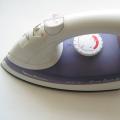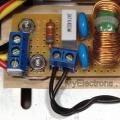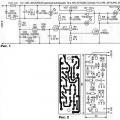We are already accustomed to the basic parameters of a capacitor: capacity and operating voltage. But recently, its equivalent series resistance (ESR) has become an equally important parameter. What is it and what does it affect?
Since ESR most strongly affects the operation of electrolytic capacitors, in the future it will be about them. Now we will take apart the electrolytic capacitor by the bones and find out what secrets it hides.
Any electronic component is not perfect. This also applies to the capacitor. The totality of its properties is shown by a conditional scheme.

As you can see, a real capacitor consists of a capacitance C , which we are used to seeing in the diagrams in the form of two vertical stripes. Further resistor R s , which symbolizes the active resistance of the wire leads and the contact resistance of the lead - plate. The photo shows how the lead wires are riveted to the plates.
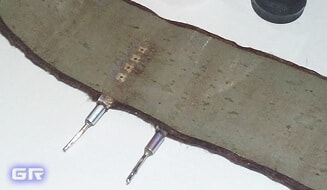
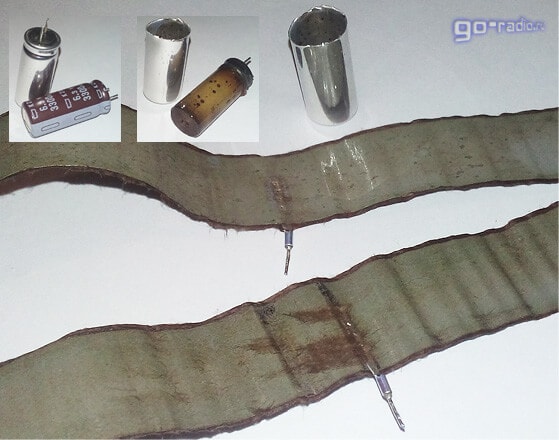
Since any, even a very good dielectric has a certain resistance (up to hundreds of megohms), a resistor is depicted in parallel to the plates Rp ... It is through this "virtual" resistor that the so-called leakage current flows. Naturally, there are no resistors inside the capacitor. This is just for clarity and easy presentation.
Due to the fact that the plates of the electrolytic capacitor are twisted and installed in an aluminum case, inductance is formed L.
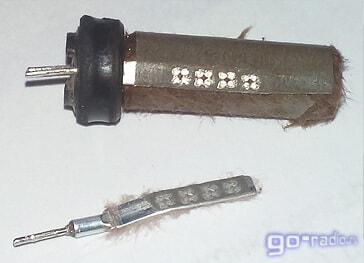
This inductance exhibits its properties only at frequencies above the resonant frequency of the capacitor. The approximate value of this inductance is tens of nanogenries.
So, from all this, we single out what is included in the ESR of an electrolytic capacitor:
Resistance, which is caused by losses in the dielectric due to its inhomogeneity, impurities and the presence of moisture;
Ohmic resistance of wire leads and plates. Active resistance of wires;
Contact resistance between plates and leads;
This can also include the resistance of the electrolyte, which increases due to the evaporation of the electrolyte solvent and changes in its chemical composition due to its interaction with metal plates.
All these factors are summed up and form the resistance of the capacitor, which was called the equivalent series resistance - abbreviated as ESR, and in a foreign manner ESR (E quivalent S erial R esistance).
As you know, an electrolytic capacitor, due to its design, can only work in DC and pulsating current circuits due to its polarity. Actually, it is used in power supplies for filtering ripples after the rectifier. Let's remember this feature of a capacitor - to pass current pulses.
And if ESR is, in fact, a resistance, then heat will be released on it during the flow of current pulses. Think about the power of the resistor. Thus, the more ESR, the more the condenser will heat up.
Heating up an electrolytic capacitor is very bad. Due to heating, the electrolyte begins to boil and evaporate, the capacitor swells. Probably, you have already noticed a protective notch on the top of the case on electrolytic capacitors.
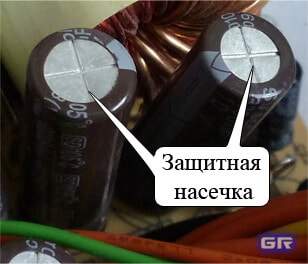
With prolonged operation of the capacitor and an elevated temperature inside it, the electrolyte begins to evaporate and press on this notch. Over time, the pressure inside increases so much that the notch breaks, releasing the gas to the outside.

"Slammed" capacitor on the power supply board (reason - overvoltage)
Also, the protective notch prevents (or weakens) the explosion of the capacitor when the permissible voltage is exceeded or its polarity changes.
In practice, it also happens vice versa - the pressure pushes the insulator from the side of the terminals. The photo below shows a condenser that has dried. Its capacitance dropped to 106 μF, and the ESR when measured was 2.8Ω, while the normal ESR value for a new capacitor with the same capacity is in the range of 0.08 - 0.1Ω.
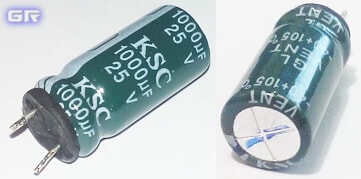
Electrolytic capacitors are produced at different operating temperatures. For aluminum electrolytic capacitors, the lower temperature limit starts from -60 0 С, and the upper one is limited to +155 0 С. 105 0 С.Only the upper temperature limit is sometimes indicated on the label: +85 0 С or +105 0 С.
The presence of an ESR in a real electrolytic capacitor affects its operation in high-frequency circuits. And if for ordinary capacitors this influence is not so pronounced, then for electrolytic capacitors it plays a very important role. This is especially true of their operation in circuits with a high level of ripple, when a significant current flows and heat is generated due to ESR.
Take a look at the photo.
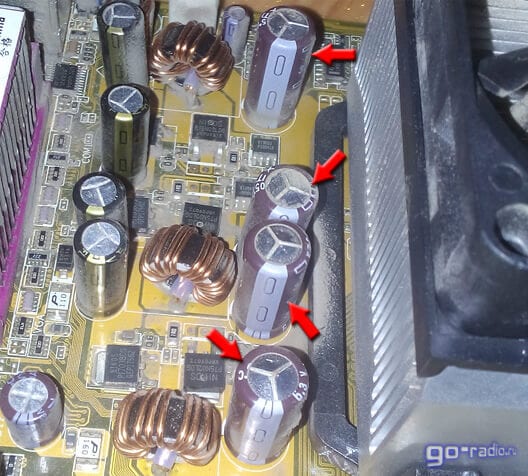
Swollen electrolytic capacitors (caused by prolonged operation at elevated temperatures)
This is the motherboard of a personal computer that has stopped turning on. As you can see, there are four swollen electrolytic capacitors on the PCB next to the processor heatsink. Long-term operation at elevated temperatures (external heating from a radiator) and a decent service life led to the fact that the capacitors "popped". This is due to heating and ESR. Poor cooling affects not only the operation of processors and microcircuits, but, as it turns out, also on electrolytic capacitors!
Reducing the ambient temperature by 10 ° C will almost double the life of the electrolytic capacitor.
A similar picture is observed in failed PC power supplies - electrolytic capacitors also swell, which leads to a drawdown and ripple in the supply voltage.
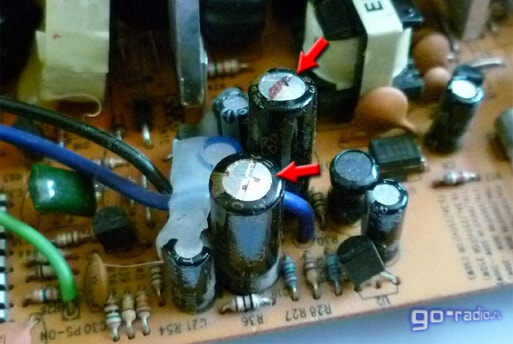
Defective capacitors in the ATX PC PSU (the reason is the poor quality of the capacitors)
Often, due to long-term operation, switching power supplies of access points, Wi-Fi routers, all kinds of modems also fail due to capacitors that have “slammed” or lost their capacity. Let's not forget that when heated, the electrolyte dries up, and this leads to a decrease in capacity. I described an example from practice.
From all that has been said, it follows that electrolytic capacitors operating in high-frequency pulse circuits (power supplies, inverters, converters, switching stabilizers) operate in rather extreme conditions and fail more often. Knowing this, manufacturers produce special series with low ESR. On such capacitors, as a rule, there is an inscription Low ESR which means "low ESR".
It is known that a capacitor has a capacitive or reactive resistance, which decreases with an increase in the frequency of the alternating current.
Thus, as the frequency of the alternating current rises, the reactance of the capacitor will drop, but only until it approaches the value of the equivalent series resistance (ESR). This is what needs to be measured. Therefore, many devices - ESR meters (ESR meters) measure ESR at frequencies of several tens - hundreds of kilohertz. This is necessary in order to "remove" the reactance value from the measurement results.
It should be noted that the ESR of a capacitor is influenced not only by the current ripple frequency, but also by the voltage on the plates, the ambient temperature, and the workmanship. Therefore, it is impossible to say unequivocally that the ESR of a capacitor, for example, is equal to 3 ohms. The ESR value will be different at different operating frequencies.
ESR meter
When checking capacitors, especially electrolytic ones, you should pay attention to the ESR value. There are many commercially available instruments for testing capacitors and measuring ESR. The photo shows a universal tester of radio components (LCR-T4 Tester), the functionality of which supports the measurement of ESR capacitors.
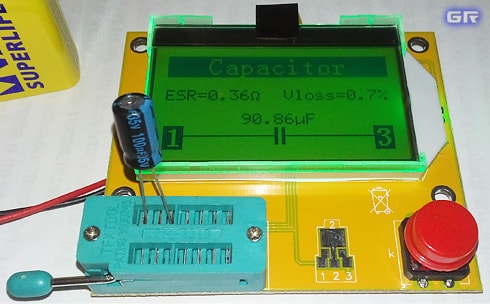
In radio engineering magazines, you can find descriptions of home-made devices and multimeter attachments for measuring ESR. On sale you can also find highly specialized ESR meters that are able to measure capacitance and ESR without soldering them from the board, and also discharge them before that in order to protect the device from damage by high residual voltage of the capacitor. Such devices include, for example, such as ESR-micro v3.1, ESR-micro V4.0s, ESR-micro v4.0SI.
When repairing electronics, electrolytic capacitors have to be changed frequently. At the same time, to assess their quality, parameters such as capacity and ESR are measured. In order to have something to compare with, an ESR table was compiled, which indicated the ESR of new electrolytic capacitors of different capacities. This table can be used to assess the suitability of a particular capacitor for further service.


